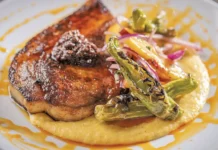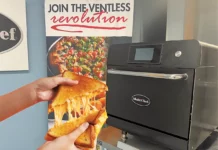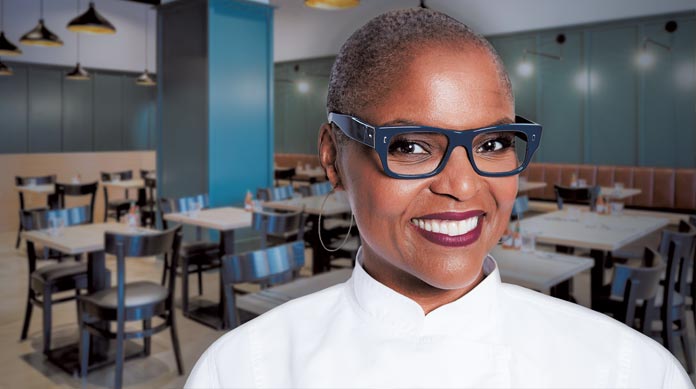
Executive Chef and Owner, Brown Sugar Kitchen
Foodservice professionals in Metro NYC are used to hearing the story that if you can make it here, you can make it anywhere. Chef and restaurateur Tanya Holland has taken that adage to a whole new level. She began her successful career in Manhattan working for notables including celebrity chef Bobby Flay.
Tanya Holland has since gone on to build a career on the West Coast that includes restaurants, books and digital media. Her work leading the Bay Area chapter of the Les Dames d’Escoffier has focused on breaking through the glass ceiling and creating opportunities for women in our industry. Total Food Service wanted to get Tanya Holland’s perspective on surviving COVID-19 and the future of our industry.
Who got you interested in cooking as a child?
Both of my parents. They actually were part of a neighborhood cooking club that would rotate through our house for 20 plus years. They were home cooks from Virginia and Louisiana. I learned early on that if people are going to get along anywhere, it’s over food and drink. It really brings people together.
At the University of Virginia, you were a Russian language and literature major. Pretty unusual background for a chef/restaurant owner?
I applied to engineering schools because I was excelling in math and science, but when I got to school, I didn’t like it. I started studying a bunch of different things, and I was getting straight A’s in Russian, so I decided, “Let’s major in that!” Even though I had no idea what I was going to do with it. I had a fantasy of being an ambassador for the State Department, but the exam was just too daunting.
My interest in language really is all about my desire to connect with people of many different backgrounds. I find that diversity to be a staple in the restaurant community with a mix of people that may or may not have college degrees. Some who went to culinary school, and others that are self-taught. Whereas in corporate America, where I had worked several summers, it was really regimented. You wouldn’t get this position unless you have that exact degree with a linear ladder dictating the opportunity to grow.
What impact did the opportunity to study in France have on your career?
It was significant in terms of credibility and credentials. The industry looks at the discipline that come with a European cooking education as representing the highest of standards. In addition, the experience enabled me to build a very diverse lifelong support network. Not everybody became a chef. Some became food writers and cooking school teachers.
When did you know it was something you wanted to do for a living?
I started taking cooking classes in 1990, and I went to cooking school the following year. But it wasn’t really to be a chef as much as it was to be a restaurateur and have an understanding of food. I was always a good cook and it came naturally to me, but I wanted to be a restaurant owner.
Where did that desire to open and operate your own place come from?
It was noticing the absence of representation in the genre of my heritage. So African American cuisine in an environment that was contemporary with service with excellent food. The example I like to give is that you could always find some down home place with good food. But the service was casual, and the room and ambiance were really casual. Or you would find a nice-looking space, but the food wasn’t there. So, I could see the opportunity and there simply were not that many African American restaurateurs. I love creating an environment and entertaining people while making them feel comfortable and feeding them.
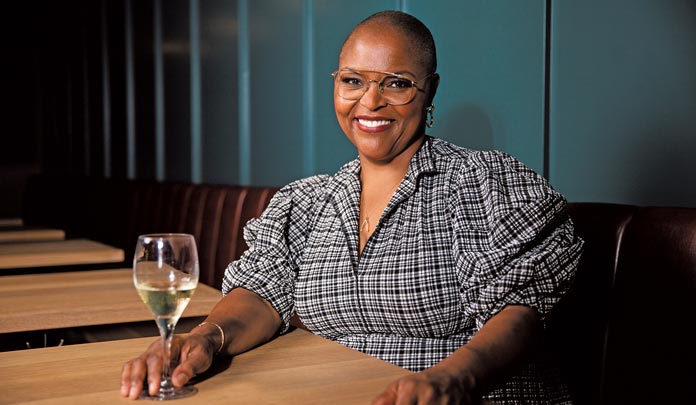
What was your takeaway from working in New York?
A number of different things. When I first worked in New York in the front of the house in the late eighties and early nineties, it opened my eyes to how many dining options there were to dine. The hustle and bustle was amazing. It was a time in which there were so many up and coming chefs including Bobby Flay, Mario Batali, Tom Colicchio and Jean Georges Vongerichten. You had so many great chefs competing with each other and launching their first restaurants, so it was fiercely competitive.
What impact did Bobby Flay have on your career?
I began at Mesa Grill as a server in 1991 before I went to cooking school. I was really inspired by him and his journey and the food there. I also learned the power of television working for him. Bobby’s success is all about picking the right partners, and to be authentic by cooking with big bold flavors. The volume that we did at Mesa Grill was really intense and that trained me for having my own high-volume place.
How did your cooking style evolve?
I was cooking French food. I went to school with a bunch of Americans. I remember we had one Thanksgiving dinner, but I couldn’t find cornmeal anywhere so I couldn’t make cornbread or stuffing or yams. There’s a lot of ingredients, like okra, that don’t translate.
What led to your leaving New York for California?
I simply wasn’t finding the type of opportunities I was looking for in New York. The way I looked at my career is that I had gone from line cook to chef because I couldn’t find the right mentors or backers even though I had been on the Food Network, or even an executive chef opportunity for which I would be properly compensated. I even thought that maybe it was time to move into teaching and writing fulltime.
I actually had one of my mentors at the time tell me that I would never find the type of opportunity in New York that I was after. I knew San Francisco was a food capital so I just decided to go for it and I haven’t looked back. I also came to the Bay Area because there were so many women chefs/owners including Alice Waters and Elizabeth Falkner.
What happened to a full time career in writing and teaching?
I actually did write my first cookbook. I got involved with Meals on Wheels in San Francisco and one of the benefactors that had tasted my food told me if I ever wanted to open my own place, she would invest in it. That led to meeting with a landlord, who also wanted to invest. So in 2008, we were able to open Brown Sugar Kitchen.
Congratulations, twelve years is an eternity in the restaurant business.
It’s a good run and ironically, we are now in the original space that I wanted to rent in ‘08. I tried to rent probably about a dozen other spaces and more prominent, neighborhoods with more business and residential foot traffic. Originally, I didn’t have access to those leases. I didn’t have enough backing, so I ended up at a former truck stop in West Oakland.
I raised very little money, $5,000 to 10,000 here and there from developers who want an amenity like nothing they had ever seen. I bootstrapped and it became a destination place. We succeeded by providing a consistent product. Good service and delivery more than people expected. That led to a substantial amount of media attention which created a reputation and access to more funding. Soon we had a 2nd BBQ spot that got great press but wasn’t profitable and I had to close it. We ventured into San Francisco but eventually had to close it. So we are back where we began in Oakland.
What are the differences in a restaurant succeeding in San Francisco vs Oakland?
The clientele is much more transient in San Francisco, so you don’t get as much customer loyalty. The particular location I was in has evolved into a very touristy area. I just wasn’t a fit. There are several places that people seek out in Oakland. For the most part, Oakland just has residents that are really committed to supporting Oakland. It’s a very proud community.
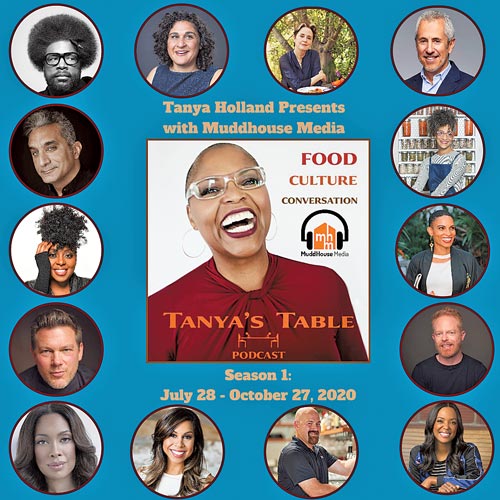
We are curious for your thoughts on the differences between succeeding on the East Coast and succeeding on the West Coast?
On the East Coast, most restaurateurs were male, white or of European descent. A male chef told me in the early or mid-nineties that I needed to leave New York City to succeed. And I was like, ‘What? No, I don’t want to.’ He told me: No, it’ll be really hard for you here to get the kind of support that you need as a woman and let alone a black woman.
I like to use this example: if you watch Chopped on TV, you’ll see Alex Guarnaschelli, who was my roommate in cooking school. Amanda Freitag was a sushi chef at a restaurant I cooked at. Both of them are incredibly talented. They have media presence and yet have struggled to open and keep restaurants. That speaks to how challenging it is for women to really get established and build a business the way the men do. There’s certainly exceptions for sure, but, you look at their resources, their gifts and what they can do. They’re both fairly ambitious, so it’s like, wow, why are they not there yet?
What positives do you see coming out of the last five months with the Pandemic?
I am already seeing it with my new landlord. He is amazing and has become a true partner. He’s an investor, and we’re going to percentage rent because I win, he wins. But if I lose, then he loses, you know? And pre-COVID, they hadn’t been seeing it that way. Landlords are starting to see that restaurants are in many cases the fabric of a community. We are not robots; we need social interaction and dining provides that.
You touched on food journalism. Where does TV and cookbooks and restaurants in Las Vegas fit in terms of building your brand?
Those are elements all on my list. I try to emulate what the Bobby Flays, Emerils and Batalis have done. Because I know that I have the talent and desire to accomplish what they have done. It’s all about getting on the right radar. Our next step will have a kiosk with our fried chicken sandwich at the Raiders new Allegiance Stadium in Las Vegas. I would love to see that grow into an opportunity at one of the hotels there. Bobby Flay told me that having a place in ‘Vegas is like having an annuity. I know that our brand has legs because I have heard from landlords and developers around the country.
What impact has Les Dames d’Escoffier had on your career?
A mentor of mine who was involved in food writing asked me if I wanted to teach classes in Mexico at a cooking school. That turned into a conversation about Les Dames and she offered to sponsor me for membership. So in 2010, I became a member and it gave me the opportunity to learn from those with far more experience than I had.
We’ve been able to build the Bay Area chapter into something that is so special. We have created local scholarships for food writers’ chapter, and we just added a culinary scholarship. It is so rewarding to have an opportunity to give back within your industry and to really mentor and impact careers. The national conferences have enabled me to build an incredible national and international network that has opened so many doors.
Has the industry finally empowered women and broken through the glass ceiling?
I think it’s too soon to tell. I’ve seen a lot of great change with groups over the years, including the James Beard Foundation offering great women’s entrepreneurial leadership classes as well as regional summits. It’s great to see kitchens I couldn’t work in, now having women in leadership roles. We’ve woken up, but there’s still a long way to go. We need companies like Compass and the Chili’s and Cheesecake Factory conglomerates and hotels to help us take the next step.
Where is the restaurant industry in terms of race, creed, and color impacting the ability to succeed, given the emergence of Black Lives Matters this summer?
You can only imagine the number of interviews and conversations I’ve had since that Friday; it’s been insane. It’s too early to tell if this is going to be a little blip, or whether we really are going towards longstanding change. I do believe we are, because there’s enough of a population of African Americans in the industry. We just haven’t been empowered with the access to the same funding opportunities, information, and promotions. What’s disappointing is that I’ve worked to earn a certain amount of privilege and resources and I still have trouble getting where I want to go. So I am concerned if I can’t get there and that’s not my ego, then how is the next generation going to get there? I’m fine with being a pioneer and taking a hit for the team but it gets exhausting. It’s happening though, I do see progress after 30 plus years.
I noticed that you’re an accomplished figure on Instagram and on social media. What role does it play?
I don’t use it to tell my story as much as using it to share events I have attended. I use it to help journalists tell our story until I get the time and space to write my memoir. The really interesting trend is how you used to have to be in a major city, recognized by the James Beard Foundation, or a national magazine. What’s happened is that many chefs decided that they don’t want the overhead of a big city, so great chefs can now be found everywhere and social media enables them to share their stories. You now see these incredible culinary scenes in cities like Asheville, Charlotte, Louisville, Cincinnati and Cleveland.
As you look at 2021, what’s in the Crystal Ball for the Tanya Holland brand?
I am working on a third cookbook, would like to create a presence in wine country, do more TV, we are looking at launching another podcast and even a line of frozen product for supermarkets.
I can hear that same passion that “got you there” in your voice.
For the first time in a long time, I can see the opportunity for real true positive change in our industry. I feel like my voice is visible and amplified. People may have thought I was acting like a victim, but I just wanted the opportunity.
To learn more about Tanya Holland, visit her website or follow her on Instagram.


















